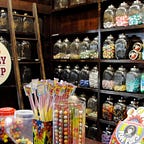How to say more with less
When you first bring your reader onto a scene, it’s tempting to give them the full picture. Floor to ceiling, head to toe — you want to show every tiny detail. You’re dying to give your reader a glimpse into your world so they can see it exactly how you see it.
But that’s just it. They only need a glimpse.
If your scene descriptions look like this…
I laid out four of my best bone china plates — remembering to turn the intricate blue iris pattern slightly to the left — in front of four dark oak lattice-back chairs, each with a white upholstered cushion. The six-foot mahogany dining table was finally picture-perfect when I set out my grandmother’s red satin runner with gold tassels on either end.
…I have news for you. That’s way too much!
The reader has been handed so much information, their imagination has stopped. And when the imagination has stopped, so has the story.
But you can still be descriptive. In fact, by saying less about the scene, you paint a much more interesting picture. There’s an easy trick to it, too:
Two visuals, one other sense.
That’s it!
Here’s how it works.
Choose two of the most pertinent (or most interesting) physical objects or visuals in your scene. You can use adjectives to describe them, but not too many. Now, pick another sense: taste, touch, smell, or sound. This rounds out the scene by grounding it in reality.
Here’s the dining table scene using the two visuals, one other sense trick.
I laid out my grandmother’s red table runner between four china plates. The scent of roast turkey filled the air.
This is a much more immersive experience. I didn’t mention the table or chairs at all, but the reader knows they’re there. The reader probably assumes this is a fancy meal, too, because when else would you put out an heirloom runner and china plates? Your mind probably filled in side dishes, potential dinner guests, and even the preparation that it took to make the turkey.
It’s all there in the scene, too. I just took it away so you can imagine it yourself.
When you describe a new scene or a character, all you need to do is give the sense of the moment.
Two visuals, one other sense.
Here’s another example to prove that it works in fantasy, too. I’ll even do it backwards so you can see how your imagination gets bogged down with too much detail.
The clang of the knight’s bootfalls echoed in the high-ceilinged stone hall. Moonlight glinted on his sword as he slowly drew it from its sheath.
The two visuals here are the glinting sword and the high-ceilinged hall. We hear the bootfalls clanging, which makes the scene more dynamic. We know it’s late at night, his boots are probably made of metal, and there’s not much else in the hall because of the echoes. He’s drawing his sword, but we don’t know why. The reader has a lot of questions at this point, so they’ll want to read on.
Let’s try this scene with more detail.
At a quarter past midnight, Sir Lancelot entered the great hall where he and the other knights had dined on turkey legs earlier that day. Now, the great hall was empty, echoing, and moonlight streamed in through the arrowslits and pooled on the gray stone floor. He scanned the high-ceilinged room and slowly drew his jewel-encrusted sword from the leather scabbard at his side.
Yes, this scene gives a lot more backstory and some of the imagery is richer. Now you know the knight in question is Lancelot, he ate turkey with some other knights (off bone china plates, perhaps?) and the sword has jewels on it. You can see the hall a little better, too.
This is all great information, but you probably already mentioned it. And if you haven’t, you have the whole rest of the story to flesh out the scene. We still don’t know why he’s drawing his sword, but I guess that’s what the next paragraph is for, isn’t it? We’ll get to it.
One more.
The burglar’s heart pounded in his chest while Mona Lisa’s tight smile peeked out from under his elbow.
Whoa! That’s a ton of information! You know there’s someone stealing the most famous painting in the world and because he can feel his heart pounding, you know he’s very nervous about it. You’re probably envisioning the Louvre, likely late at night. And given Mona Lisa’s smile, you might even get a sense of what the painting itself thinks about being stolen.
I could’ve put all that in the scene, but info dumps release tension. And nobody likes a tensionless heist.
Now let’s hear from you. How would you use the sense of taste to round out a scene? And feel free to use these prompts as the openings to your story! I’d love to see the stories continued in the comments below.
Sarah Czarnecki is a freelance writer who focuses on pets, travel, and oddities while occasionally dipping a toe into fiction. Learn more about who she is and why she writes at her eponymous website.
